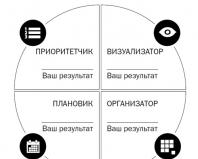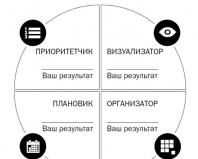Tea house made of salt dough. House for a gnome made of salt dough. Master Class. #4 DIY autumn wreath: step-by-step master class
03 01.2016
03. 01.2016

Catherine's blog
Bogdanova
Good afternoon, friends, readers and guests of the “Family and Childhood” website. Christmas is approaching. Christmas holidays are a special time of year. It is not at all surprising that right now adults are awakening to an insatiable desire to transform their home and decorate every corner of it.
It is clear that not so much for themselves, but for the children, who are waiting for it more than anyone else. In this master class we will look in detail at how to make a house from salt dough with your own hands.
Materials used
The following materials were used during the work:
1) ordinary thick cardboard;
2) masking tape;
3) salt and flour;
4) PVA glue;
5) gouache paints;
6) old tulle (small piece);
7) just a little plasticine;
8) fluffy garland of small diameter;
9) yacht varnish.
The tools used were small scissors and a knife, paint brushes, a sponge, a pencil, a varnish brush and double-sided tape.
Work order
This was my first craft made from such material, so several mistakes were made during the work, which will definitely be mentioned. So making this New Year's decoration took place in the following order.
Stage one
The frame of the house is assembled from cardboard. The front and side walls are made of ordinary thick cardboard for children's crafts. The roof is made of even thicker cardboard (a folder for its sheets). But the back wall is made of thin cardboard - the first mistake.
The wall began to bend under the weight of the dough. She urgently began to strengthen it in sections, which did not help much. The side wall is half of a whole sheet. On the roof I made a canopy for the attic window from a triangle. The chimney was glued to the top, windows were cut out and a door was drawn. The roof is not glued to the base at this stage.




Stage two
After assembling the frame, the dough is kneaded. The proportions are standard: one glass of salt and flour, half a glass of water, a tablespoon of sunflower oil. I added a little PVA glue to the first portion (a little more than 1 tablespoon).
It was noticed during the process that the dough with glue from the first batch dried faster than the dough from the second batch, to which no glue was added. When preparing the first portion, I first dissolved a little salt in water and immediately added glue - the second mistake.
The salt began to stick to the glue in lumps, so I threw away the first sample. I diluted a new portion and added glue to the already ready dough, which I mixed thoroughly. It is very difficult to work with freshly prepared material (it constantly sticks). First I put it in the refrigerator for a couple of hours, and then took it out in small portions.

Stage three
The frame was not processed in any way (not primed, not scratched, etc.) to improve its adhesion to the dough. Using a rolling pin, roll out a small piece of dough into a flat cake. It is very difficult to roll out a large piece on the entire wall at once, since the dough breaks and sticks to the countertop.
Therefore, three cakes were laid on the wall, the edges of each were cut off (they were carefully joined together with fingers and aligned). Above the windows, the excess dough was simply cut out with the tip of a knife. The same knife was used to cut lines that imitate brickwork- third mistake.
At first I tried to stretch the blade from one edge of the wall to the other, but the dough constantly moved and pulled out of place. The lines need to be pushed through, rather than trying to cut through.






The door frame is made from thin strips of dough that are simply applied to the wall (not glued to anything). There are thin stripes on the door that imitate boards. The frame around the round window, the wreath on the door and door knob. The wreath was first in the form of a small donut, and then small thorns were cut out of it using nail scissors.





Stage four
Inside the house on the windows using masking tape small pieces of unnecessary tulle are glued. If you want, you can also do some furniture, rather than leaving the house empty. Furniture can be made from the same material from which the house itself is made. Now you need to secure the roof.
Thick strips of dough are placed on the upper edges of the walls. For reliability, glue was applied over the strips, which will fix the roof. Then cakes of dough are also placed on the roof. The relief on the roof was made with a simple pencil, the dough was pressed with the blunt side and indentations were made. The attic window was simply pressed out with a knife blade and decorated.



You can make a beautiful house for a gnome from salt dough with your children, having fun together. Salty dough It's very easy to prepare. Decorating the house is also simple.
Confectionery unusual shape always seem tastier and look original. Such a house can be placed on a cake as a decoration or made for fun while playing with children. The idea behind this toy house I received it when we ordered custom cakes in Moscow for my daughter’s birthday. One of the cakes was made in the form of a forest clearing on which stood small house. The cake was very original and delicious. Now let's make a similar house from salt dough. It's not difficult at all!
We will need:
- salty dough;
- rolling pin;
- sharp knife;
- paints;
- brush;
Our house will be hollow inside. To do this, take a bottle and wrap it in foil to make it easier to separate the dough from the bottle later. When the dough dries, the foil will easily peel away from the glass.

Cut a piece of dough and roll it out with a rolling pin to a thickness of 0.5-1 centimeter. Cut a rectangle equal to the circumference of the bottle. Wrap each bottle and seal the seam with water. Take a brush, wet it and go along the seam.

The walls of the house are ready, now take a sharp knife and cut out the window. I made a window and doors, you can do the same. They can be of any shape.

In my case the window has square shape. Then I decorated it with shutters, use my fingers to make a semi-circular window sill. Cut a thin strip and glue it to the top of the window. Roll the dough into small peas, flatten with your fingers and decorate the top and bottom of the window. Wet the pieces with water before gluing.

Turn the house towards you back side. Let's cut out the door here. It will be semicircular - arched. Decorate the outline with pebbles. Make three semicircular steps. The entrance to the house is ready. You need to make a door. Cut out the dough according to the shape of the entrance and use a toothpick to make three grooves on top, and stick three thin sausages across it.

I really want to decorate such a house, because it is fabulous. I decorated it with sunflowers. Each petal is cut out separately. You can just do big flower with round petals - it's quick and easy.

Insert the door into the opening, do not forget to constantly moisten the adhesive surface with water. This is such a beautiful house you have.

Now let's take care of the roof. Take a cork and wrap it in foil to form a roof shape.

Roll out the dough into strips and make tiles by hand. Wrap the cork around the bottom and bring the edges together. Then make another ribbon and glue it on top. And the third layer: make a cake, cut out an openwork edge on it and cover the dome.

You can make a pipe like this: take a handle, wrap it in foil and stick the dough onto the foil. Insert into the roof and secure with water.
Good afternoon friends!
I really like salt dough houses. And I decided to do the same when I chose a free minute. And at the same time I’ll show you how to sculpt from salt dough. I won’t describe much and in detail, since it seems to me that the entire sculpting process is visible in the photographs. Only as the process progresses, I will make some clarifications.
House - a vase made of salt dough:
I made the salt dough according to the standard recipe:
I take 100 gr. salt + 100 gr. flour and add enough water so that when kneading the dough, you get a mass reminiscent of plasticine.
I decided to make a house in two parts - the base of the house and the lid. I plan to use this house as a vase to give the atmosphere a romantic or fairy-tale mood.
For the base I used trimmed bottom part half a liter bottle and wrapped it in foil.
I wrapped the base with dough. I made a window on one side and an entrance on the other.

I cut the dough into squares. And she decorated the entrance arch with them.

First I decorated the window with small cakes – “stones”. And then the walls of the entire house, right up to the entrance. The result was stonework))
I gave the stones texture and used a bone for this.

Then, the house was placed on the foundation.
The base was also covered with “stones”. Then, I decided to block the door and window from the inside. I made cakes and stuck them inside the house.

Now, I decided to decorate the house with flowers. I marked the places with a pencil.

I cut out flowers and stuck them in the planned places.
Having finished decorating, I covered the joint between the house and the base with dough. I applied pieces of dough and pressed it down. At the same time giving texture.







This is what I ended up with.

When the product dried on the base, I dried it in the oven over low heat with the door open.
I did not film the process of painting the house, because it is the same as that of the trunk - first it is applied thick layer paint, left until dry, then the top layer is lightened with a moistened cotton wool.
I varnished it with regular construction varnish.

I only got 2 final photos, since my baby got to the house (as well as to everything new with the help of a chair and natural dexterity), accidentally knocked it off the closet shelf and smashed it to smithereens...

Modeling a salt dough house
Friends, if you found my master class useful, share it with your friends!
You can create such funny houses and windmills with your children. I sculpted this mill about a year and a half ago, I saw a photo on the Internet and I really liked the idea. Unfortunately, I didn't remember the author. The house is built similarly. Inside these" architectural structures" are hollow, they have windows and doors that open. Since inside the house free space, it can be used as a candlestick, place a small candle inside. To hot air came out unhindered, I even made a pipe on the roof. But don't forget the rules fire safety, do not leave a lit candle in the product unattended!
Stages of work:
 We prepare materials. To make the house hollow inside, I take a bottle suitable size and wrap it in foil. This is so that the finished house can be easily removed from the bottle, otherwise the dough will stick to it. When the house body dries a little, the foil with inside very easy to remove.
We prepare materials. To make the house hollow inside, I take a bottle suitable size and wrap it in foil. This is so that the finished house can be easily removed from the bottle, otherwise the dough will stick to it. When the house body dries a little, the foil with inside very easy to remove.
I roll out the dough with a rolling pin to a thickness of 0.5-1 cm, cut out a rectangle from it equal to the circumference of the bottle and place it on foil. The seam must be lubricated with water to better bonding, for this purpose I always have a glass of water and a brush on hand.
Salt dough is the most best material for creativity with children. It is very plastic, harmless, easy to prepare, and the parts are glued together with water. Many children, after the dough has dried on the radiator or baked in the oven, like to taste the finished product. My niece also bit off pieces of crafts made from salt dough more than once and said that it was delicious. And one girl from the studio complained that when she prepared the dough figures and dried them, her dad and friends ate them with beer :) Sorry for the slight digression, what I mean is what kind of stuff are they? useful invention for mothers, and there is no need to buy plasticine - flour, water and salt are always at hand. And the child’s health will not suffer if he tries salt dough during the creative process.
Stage 2
Now that the walls of the house are ready, use the edge of a knife to cut out the holes for the windows. They can be round, square, rectangular. I'm in in this example I made one window and a door for the house.
I rolled out another piece of dough, cut out shutters and a window sill from it, glued it onto the base and formed a window. I laid bricks around the perimeter of the window and door. To do this, I rolled out small balls with a diameter of up to 1 cm in my palms, flattened them with my fingers, smeared them around the window and door with a brush dipped in water, and glued the so-called bricks.



Stage 3
On the surface of the door, which was previously cut from the wall of the house, I imitated planks. When the miracle building is completely ready, I will fix the door in doorway using wire on one side of the wall. The door can be opened and closed after the house is completely dry.
Stage 4
I wanted to decorate my house. I sculpted one sunflower on each side of the door. Each petal is sculpted by hand and glued to the center of the flower.



All that remains is to make the roof. I have a lid of a suitable size on my sugar bowl; you can also cut off the neck from plastic bottle or use another suitable material shaped like a roof, which needs to be wrapped in foil. Now I’m making tile blanks. I connect them together using water (see photos below). I had to tinker with the pipe. I wrapped some foil around a ballpoint pen, bent it a little at the base of the pen, and inserted it into the hole on the roof. Then I covered the foil on the handle with dough.




